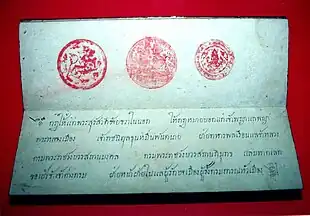
A copy of the Palace Law, displayed at the House of Representatives of Thailand
The Palace Law (Thai: กฎมนเทียรบาล, also spelled กฎมณเฑียรบาล, RTGS: kot monthianban) is a class of legal texts in the history of Thailand, dating from the Ayutthaya period (14th–18th centuries). It prescribed the functions of the monarchy, royal court and government, probably serving like a constitution during early Ayutthaya.[1] It was one of the 27 laws compiled in the 1805 Three Seals Code on the orders of King Rama I, following the fall of Ayutthaya.[2]
Today, a handful of palace laws dating from the reign of King Vajiravudh (Rama VI, r. 1910–1925) remain in force, the most significant of which is the 1924 Palace Law of Succession, which is deferred to by the constitution.[3]
References
Citations
- ↑ Seni Pramoj, quoted in Baker & Phongpaichit 2016, p. 51
- ↑ Baker & Phongpaichit 2016, p. 1
- ↑ รังสิทธิ์ วรรณกิจ (2017). "กฎมณเฑียรบาล". wiki.kpi.ac.th (in Thai). King Prajadhipok's Institute. Retrieved 17 October 2019.
Bibliography
- Chris, Baker; Phongpaichit, Pasuk (2016). The Palace Law of Ayuttaha and the Thammasat: Law and Kingship in Siam. Cornell University Press. ISBN 9781501725968.
This article is issued from Wikipedia. The text is licensed under Creative Commons - Attribution - Sharealike. Additional terms may apply for the media files.